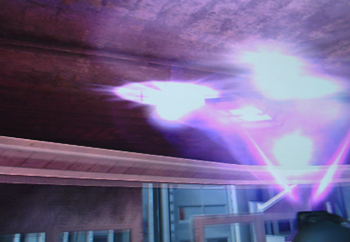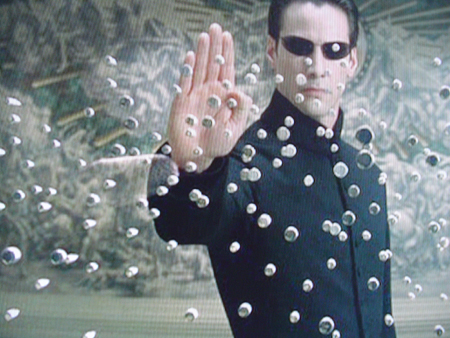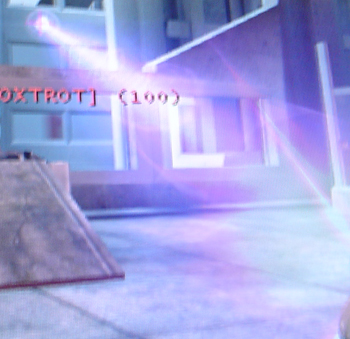A Guide to Choosing the Right 19" LCD Monitor - 7 Models Reviewed
by Kristopher Kubicki on November 30, 2004 12:04 AM EST- Posted in
- Displays
Application Analysis
The core of our LCD benchmarking comes from real application analysis. We play with a lot of monitors and it gets easier for us each time to pick out problems with an LCD just by using the right application. Here are a few quick looks at some demanding full screen applications. We already ran ColorVision's OptiCal software, so all of our monitors are calibrated and adjusted to the same curves.High Definition Video - We cheated a little bit on this portion of the analysis and handicapped all the monitors. None of these LCDs can display a true HD signal correctly without compressing pixels or cropping the image. Nevertheless, we set out to play a WMV9 1080i signal on our monitors with the interest in looking for color differences. Since our monitors have all been precalibrated, we expect the same image on each screen. Unfortunately, no amount of calibration can fix some things; we still noticed "off" reds on most of the monitors (including the Samsung 193P, the Sony, the Planar and the Dell). The BenQ, NuTech and ViewSonic occasionally managed to wash out blues a little too easily, and when looking in the right places, we could easily spot some of the differences between the 6-bit BenQ image.
The Matrix Reload, The Matrix - We use the Matrix series to test full motion video on our LCDs. Since the Matrix isn't the best movie to test color reproduction, we typically only look for motion blur or other imperfections. As expected, we noticed no fatal flaws in any of the LCDs. Although, while running some of them side by side, it became readily apparent that some monitors put a slight hint of color on the application - noticeably, the NuTech and ViewSonic monitors had a slight bluish tint.
WarHammer 40K, Dawn of War - When looking for a monitor's response time, we generally only consult first-person shooters for reference. However, those of you who have played a fast-paced game of Warcraft III or NeverWinter Nights will know that scrolling around for hours puts a severe tax on the monitor. Although we didn't notice any profound difference on the 16ms BenQ monitor, we could tell that the Sony and Planar had occasional difficulty in poorly lit areas of the game. For example, when scrolling around the last level of DOW where the majority of the level is gray ash and black soot, we would see the edge of the menu bar and status icons bleed into the ground.
Looking closer, we noticed some small differences with heavy weapons fire while scrolling on the BenQ FP931 and Samsung 193P. With enough patience, we can actually count the tracers shot over long distances, but when viewing the same scene on the Planar PE191M, the same task seems almost impossible. Attempting to do the same on the ViewSonic LCD proves futile sometimes, but not others.
Max Payne 2 - The extreme light and dark transitions in Max Payne still provide us with the sufficient criteria to benchmark transient response time; specifically, we can focus on the light and dark extremes. However, in all of the demos that we ran, we noticed virtually no difference from one monitor to another. The Samsung 193P looked a little more vibrant than its competitors, but the NuTech and ViewSonic models were displaying particularly brighter lights while maintaining the same dark hues as the SyncMaster 193P. Revisiting Max Payne with the Dell 2001FP was a little bit of a surprise. Even with the brightness set to its maximum, we were a little surprised at how much brighter the 19" LCDs were running.
Halo, Unreal Tournament 2004 - Halo and UT2K4 have very similar results, but now, we are looking for fast motion and color correctness at the same time. Again, we noticed a slightly blue tint to the BenQ monitor even after it was corrected with OptiCal. All of the monitors had a tendency to wash out, particularly in bright areas, and part of that is because we are running all of our monitors at the highest brightness levels. Specifically, the BenQ and Samsung 910V would wash out especially in bright explosions (a well-placed Redeemer usually did the trick). On occasion, the Sony SDM-934 and the Planar PE191M would blur in heavy laser battles (4 or 5 shock rifle shots firing across the screen would usually leave a small trail).

ViewSonic Q190MB
Click to Enlarge.














97 Comments
View All Comments
Cat - Tuesday, November 30, 2004 - link
Kristopher, could you comment on the perceived lag that I've felt on three different 2001FPs? There's no ghosting, but the delay between moving the mouse and having an update on the screen is horrible. DVI-I and D-SUB, different video cards, systems, the works, they all have it.I don't see this on the other LCDs here at work. I know there was a Slashdot post about this a while back, and some have said it's caused by bad batches, but three of them having the same problem? I don't know if I should send my personal 2001FP back ...
InuYasha - Tuesday, November 30, 2004 - link
>Umm, yeah what up with that? Why can't someone >explain the reason to get a 19" versus a 17" if >the resolution is the same (ignoring that the >dot pitch is bigger thus easier to see).It's the same friggin reason why people buy a 50" TV instead of a small 20"
InuYasha - Tuesday, November 30, 2004 - link
>"Recall that 19" LCDs have roughly the same >viewing area as 21" CRT monitors, and that 17" >LCDs have about the same viewing ANGLE as 19" >CRTs.">angle = area in this case?
>Some stories get edited well on anandtech, and >some not so well...
a 19" LCD is measured EXACTLY 19"image display size, but a 19" CRT is usually like 18" or 17.x", the 19" is usally the glass size, not the actual image size for CRTs
sonicDivx - Tuesday, November 30, 2004 - link
Umm, yeah what up with that? Why can't someone explain the reason to get a 19" versus a 17" if the resolution is the same (ignoring that the dot pitch is bigger thus easier to see).Also why not list the settings you used for each monitor to attain the results you got (during subjective tests). This way we could set the LCD to your spec and go from there. Where is the Samsung 912N in review, its a common LCD out there?
>HelToupee
>viewing ANGLE as 19" CRTs."
>
>angle = area in this case?
HelToupee - Tuesday, November 30, 2004 - link
In the second paragraph on the first page:"Recall that 19" LCDs have roughly the same viewing area as 21" CRT monitors, and that 17" LCDs have about the same viewing ANGLE as 19" CRTs."
angle = area in this case?
Some stories get edited well on anandtech, and some not so well...
IHYLN - Tuesday, November 30, 2004 - link
I'm no english major but "more are better" "less are better" in some of the graphs made me wonder.nastyemu25 - Tuesday, November 30, 2004 - link
I agree, let's see a Sony HS-94P/B with x-black technology review!ocyl - Tuesday, November 30, 2004 - link
Should have dropped Benq's colour scores to 2 (or 1, even) for its decision to use a 6-bit panel instead of a True Colour (8-bit) one :PFilibuster - Tuesday, November 30, 2004 - link
>I think there have to be gamers here, and I do not think LCDs are there yet when it comes to refresh rates; it would have been nice to see the refresh rates on the monitors at 1024, 1280, and 1600.LCD displays don't have a refresh rate at any resolution. There is no flicker to be worried about.
Ensign - Tuesday, November 30, 2004 - link
In the Intro, it says, "A reasonably cheap, new 21" CRT runs for about $350; a reasonably cheap, new 21" LCD runs for about $330." I'm guessing that was supposed to say 17" or 19" LCD?